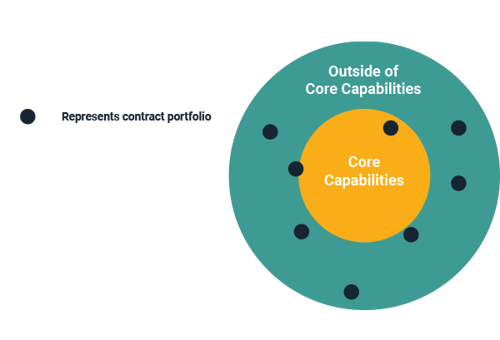What a Chaotic Pipeline Looks Like

The overall value of a federal contractor's pipeline is not based on quantity, it is quality. This sounds super simple and like it would be a no-brainer, but you have probably fallen victim to the "win anything" mentality more times than you would like to admit. High-dollar opportunities help drive revenue, but when revenue is sacrificed for company identity, it creates chaos in the pipeline and pushes companies into an environment that is difficult to change.
What Does "Win Anything" Mean?
A "win anything" mindset is almost exactly what it sounds like. It means you think you can win anything. Now, as a professional athlete, this is the right mindset to have. As a federal contractor, not so much. This means that any and all opportunities that sound good or look like they could be won, are added right into the pipeline.
This makes it extremely difficult for business development and capture teams to decipher which opportunities should be prioritized and which direction the company is headed. It leads to the prioritization of misaligned and weaker opportunities taking precedent over stronger, more aligned opportunities.
Win anything leads to:
- A contract waterfall that disconnects a company from its core capabilities.
- Contract wins outside of core capabilities endangering future pursuits.
- Revenue dependency on misaligned work.

Once the "win anything" mentality takes over, it becomes a very difficult problem to overcome. Employees begin to lose focus on what they should be chasing because the only goal that matters is generating as much revenue as possible. Although revenue is a large piece of the puzzle, it should never be the catalyst behind a pursuit strategy. Just because you can win does not mean that you should want to win it. It could end up doing more harm than good.
Think about when someone asks if you can walk to a destination. You can walk anywhere you want, it is just a matter of how far you want to go and how long you want it to take before you arrive at your desired location. You may be able to win certain opportunities, it is just a matter of what it can do for you and how closely aligned to your capabilities it is. The further it is from your core, the more distance you put between yourself and your future goals.
Stop Asking "What"
Asking "what" has its place. You can ask "what is for lunch" or "what was the score of the game last night". When it comes to your pipeline, stop asking "what is in it". When this question is proposed, it fails to identify why opportunities are in the pipeline and focuses on an arbitrary number to hit. It fails to address the long-term value of each pursuit and merely focuses on the short-term gains. Opportunities should never automatically be added to a pipeline without a rigorous vetting process. Just because it exists does not mean it should be in the pipeline. When this happens it leads to a chaotic pipeline.
What a chaotic pipeline looks like:
- Revenue is the primary driver for opportunity identification.
- Short-term actions trump long-term thinking.
- No long-term forecasting.
- Reacting to the government's actions, not influencing them.
Start Asking "Why"
When teams start asking"why", it communicates vision, helps establish a culture focused on company identity, and places a priority on wins that support future success. It puts leadership's focus on the pipeline and allows for improvements rather than questioning or critiquing an individual.
Asking "why" can change the quality and effectiveness of a pipeline to establish proper criteria for opportunity identification. An effective pipeline is designed to increase the effectiveness of resources rather than spreading them thin.
With Federal Compass, we provide you with the tools and resources to help you answer the "why". Personalized to your business based on its past performance, unique DNA, and future plans, you can analyze your addressable market and find more qualified and aligned opportunities to create a more valuable pipeline.
Download our free eBook to see how we help you identify risks, how you can mitigate them, and how you can build a more robust pipeline management system

